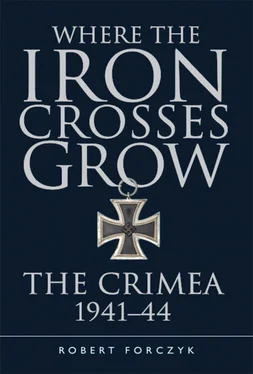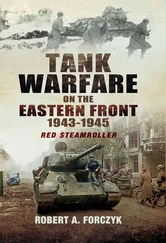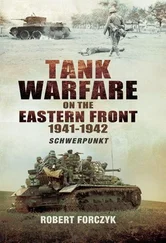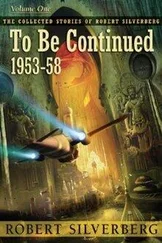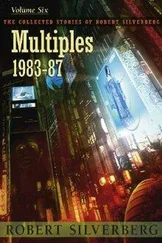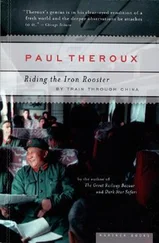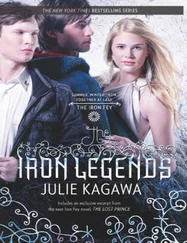General Yakov Slashchev’s 2nd Corps deployed 3,000 infantry on a ½-mile-wide front at the Chongar, which was also heavily fortified with barbed wire, six lines of trenches, and even a few concrete bunkers. Several large coastal guns were taken from Sevastopol to reinforce the Chongar position. Slashchev ordered the Salkovo railroad bridge blown up, leaving a mile-wide gap across the Sivash. Wrangel kept the 12,000 mounted troops of the Don Cavalry Corps back at Dzhankoy as a mobile reserve. Given that the Bolsheviks had absolutely no naval forces on the Black Sea, Wrangel believed that his forces, led by these two skillful and experienced commanders, could hold the only gateways into the Crimea. British military aid continued to arrive in Sevastopol, enabling Wrangel to rebuild the battered Volunteer Army with fresh equipment and uniforms; the British even provided 45 tanks and 42 aircraft to reinforce the White defenses in the Crimea. Meanwhile, those remnants of the Black Sea Fleet that had not yet been scuttled sat rusting in Sevastopol, and although short on both coal and trained sailors, were available to provide Wrangel with naval gunfire support.
With the Russian Civil War in its final spasms by late 1920, the Red Army was finally able to direct sufficient forces to retake the Crimea. Mikhail Frunze’s Southern Front dispatched five armies toward the Crimea in October 1920, consisting of 186,000 troops. Yet despite an overall 5-1 superiority in manpower and 4-1 in artillery, Frunze would be able to deploy only a fraction of his forces at either Perekop or Chongar. It was the same kind of situation that faced the Persian army at Thermopylae in 480 BC, where terrain greatly reduced the advantage of superior numbers. With this in mind, Kutepov waited at the Perekop, trusting to barbed wire and machine guns to keep the Reds out.
CHAPTER 1
The Crimea Under the Hammer and Sickle, 1920–41
“We shall now proceed to construct the Socialist order.”
Vladimir Lenin, October 1917
The men marched silently in long columns through the cold, ankle-deep mud, which held the stink of a stagnant sea. It was a cold night on November 7/8, 1920, with temperatures around 50˚F (10˚C) and very windy, which brought a chill to each man, locked in the solitude of the stealthy march. These men were soldiers of Augustus Kork’s 6th Army, who were marching 3 miles across the Sivash to outflank Kutepov’s White troops at Perekop. Frunze had wanted to make his main effort at the Chongar Peninsula, but the Azov Flotilla could not move its small craft into the Sivash due to ice at Henichesk, which was the only place where shipping could enter the confined waters. Without boats, Frunze did not believe that he could move enough assault troops across the water to overwhelm Slashchev’s defensive position. Instead, Frunze was forced to shift his main effort to the Perekop, with Kork’s army deployed to conduct a frontal assault on the Tatar Wall. [1] Mikhail V. Frunze, “Pamyat Perekop I Chongar ” [Memories of Perekop and Chongar] in Boris Gulubev (ed.) Perekop and Chongar (Moscow: Military Publishing, 1933), pp. 23–32.
Then by chance, high winds and unusual tide conditions lowered the water level in the Sivash and opened a new avenue of approach. Frunze ordered Kork to send nearly one-third of his army – the 15th and 52nd Rifle Divisions and the 153rd mixed brigade, a total of 20,300 troops – to cross the Sivash during the night. Once the Sivash was crossed, Kork would begin the main attack on the Tatar Wall the next day. Frunze believed that if Kutepov’s corps was hit from in front and behind simultaneously, it would lead to a rapid collapse. Neither Kutepov nor Wrangel expected a serious attack across the Sivash, but just in case, they deployed 2,000 Cossack cavalrymen under Mikhail A. Fostikov to screen the coast along the southern side of the Sivash.
Markian V. Germanovich’s 52nd Rifle Division began crossing the Sivash at 2200hrs on November 7, followed by the 15th Rifle Division. After about three hours, they landed undetected on the small, flat Litovsky Peninsula southeast of Perekop and, after assembling, advanced half a mile southward. Kork managed to get some light artillery across the Sivash as well, but his assault force was limited to the ammunition they could carry. Around 0400hrs on November 8, the vanguard of Germanovich’s 52nd Rifle Division encountered elements of Fostikov’s brigade, which slowly fell back toward the base of the Lithuania Peninsula but gained time for Kutepov to dispatch two regiments of the Drozdovskaya Division from Armyansk to reinforce them. By 0900hrs, the Whites had begun a major counterattack near the village of Karadzhanaya, including armored vehicles, which effectively blocked the Soviet flanking maneuver. For the rest of the day, heavy fighting continued around this village and Kutepov fed in more reinforcements from Perekop. The Soviet assault group had limited artillery ammunition, which prevented them from breaking through the White positions, and to make matters worse, the water began rising in the Sivash, isolating them. Just before the waters became too deep, Frunze sent the 7th Cavalry Division across the Sivash to reinforce Kork’s two divisions.
By the evening, Frunze’s plan was unraveling. The flanking maneuver across the Sivash had been brought to a halt and was being pummeled by White forces with superior artillery. A diversionary attack with a regiment down the Arabat Spit had also ended in disaster, with heavy losses. Frunze was not eager to begin the attack at Perekop until Kutepov’s corps was disrupted by the flank attack, but now he had no choice – he ordered Vasily K. Blyukher’s 51st Rifle Division to begin the assault on the Tatar Wall at Perekop immediately. Despite the size of Frunze’s Southern Front – on paper – Blyukher had only 4,800 assault troops in his division and 55 artillery pieces, of which 34 were light 75mm or 76.2mm guns. His arsenal of heavy artillery was limited to 12 120/122mm and six 152mm howitzers, which was clearly insufficient to create a breakthrough in a heavily fortified line. Blyukher was supposed to begin his artillery preparation at Perekop on the morning of November 8, but heavy fog prevented observed fire. Even once the fog lifted around noon, Blyukher’s artillery was unable to inflict serious damage upon the enemy defenses. Under pressure from Frunze, Blyukher committed a reinforced infantry brigade around 1325hrs to attack the Tatar Wall, which succeeded in penetrating through part of the barbed-wire obstacles before being shot to pieces by Kutepov’s machine gunners. Soviet armored cars supported the attack, but could not counter White artillery. Blyukher ordered in three more assaults during the course of the afternoon, but all ended in failure. Casualties in the assault regiments amounted to 60 percent or higher. Lacking the requisite 3-1 numerical superiority, and plagued by inadequate artillery–infantry coordination, the Red Army’s failure to break the Perekop position was typical for a World War I-type positional battle.
Just when it seemed that the Whites were on the verge of winning the battle, Mikhail A. Fostikov’s Cossacks pulled out of the fight at Karadzhanaya and retreated all the way back to the port at Yevpatoriya. Once word went around about the retreat, the morale in Kutepov’s 1st Corps cracked and other units began retreating to the reserve position at Ishun. As often happens in warfare, the Whites did not realize that the Reds were in far worse shape, and unauthorized retreats become contagious. With his flank giving way, Kutepov was forced to abandon the Perekop position and try to reform at Ishun. Blyukher’s 51st Rifle Division was so badly battered that it did not occupy the undefended Tatar Wall until the morning of November 8, and then lacked the strength to pursue. Kork urged the 15th and 52nd Rifle Divisions, which were also in poor shape, to push on to Ishun.
Читать дальше
